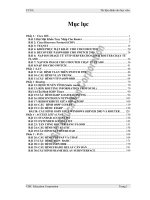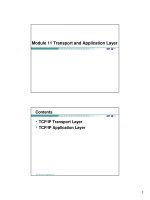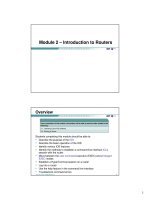Tài liệu học CCNA kỳ 1
Bạn đang xem bản rút gọn của tài liệu. Xem và tải ngay bản đầy đủ của tài liệu tại đây (512.26 KB, 18 trang )
1
Module 1 – Introduction to Networking
NIIT-ICT Hanoi 2
Overview
• Understand the physical connection that has to take place for a
computer to connect to the Internet.
• Recognize the components that comprise the computer.
• Install and troubleshoot network interface cards and/or modems.
• Use basic testing procedures to test the Internet connection.
• Demonstrate a basic understanding of the use of web browsers and
plug-ins.
2
NIIT-ICT Hanoi 3
Connecting to the Internet
NIIT-ICT Hanoi 4
Requirements for Internet connection
• A physical connection is made by connecting a specialized
expansion card such as a modem or a network interface
card (NIC) from a computer (PC) to a network.
• The logical connection uses standards called protocols.
• The application that interprets the data and displays the
information in an understandable form is the last part of the
connection.
– Web browser
– File Transfer Protocol (FTP)
3
NIIT-ICT Hanoi 5
PC basics
Small, Discrete Components
• Transistor – Device that amplifies a
signal or opens and closes a circuit.
• Integrated circuit (IC) – Device made
of semiconductor material that contains
many transistors and performs a specific
task.
• Resistor – Device made of material that
opposes the flow of electric current.
• Capacitor – Electronic component that
stores energy in the form of an
electrostatic field that consists of two
conducting metal plates separated by an
insulating material.
• Connector – The part of a cable that
plugs into a port or interface.
• Light emitting diode (LED) –
Semiconductor device that emits light
when a current passes through it.
NIIT-ICT Hanoi 6
PC basics
Personal Computer Subsystems
• Printed circuit board (PCB)
• CD-ROM drive
• Central processing unit (CPU)
• Floppy disk drive
• Hard disk drive
• Microprocessor
• Motherboard
• Bus
• Random-access memory (RAM)
• Read-only memory (ROM)
• System unit
• Expansion slot
• Power supply
Backplane Components
• Backplane
• Network interface card (NIC)
• Video card
• Audio card
• Parallel port
• Serial port Mouse port
• Power cord
4
NIIT-ICT Hanoi 7
Network interface card
When selecting a NIC, consider the following factors:
• Protocols – Ethernet, Token Ring, or FDDI
• Types of media – Twisted-pair, coaxial, wireless, or fiber-
optic
• Type of system bus – PCI or ISA
NIIT-ICT Hanoi 8
NIC and modem installation
• A modem, or modulator-
demodulator, is a device that
provides the computer with
connectivity to a telephone line.
• PCMCIA wired and wireless
NICs.
• Desktop systems may use an
internal or external NIC.
5
NIIT-ICT Hanoi 9
Overview of high-speed and dial-up connectivity
• Inevitably the high-speed services used in the corporate environment,
such as Digital Subscriber Line (DSL) and cable modem access,
moved to the consumer market.
• These services no longer required expensive equipment or a second
phone line.
• These are "always on" services that provide instant access and do not
require a connection to be established for each session.
• This gives greater reliability and flexibility, and has led to the ease of
Internet connection sharing by small office and home networks.
NIIT-ICT Hanoi 10
TCP/IP description and configuration
• Transmission Control Protocol/Internet Protocol (TCP/IP) is
a set of protocols or rules developed to allow cooperating
computers to share resources across a network.
6
NIIT-ICT Hanoi 11
TCP/IP description and configuration
NIIT-ICT Hanoi 12
TCP/IP description and configuration
7
NIIT-ICT Hanoi 13
Verify IP Configuration: Win 9x
1
2
3
4
NIIT-ICT Hanoi 14
Verify IP Configuration: Win XP, NT, 2000
• ipconfig
• ipconfig /all
8
NIIT-ICT Hanoi 15
Testing connectivity with ping
• The ping command works by sending multiple IP packets to a
specified destination. Each packet sent is a request for a reply.
• The ping command is used to test the NIC transmit/receive function,
the TCP/IP configuration, and network connectivity.
NIIT-ICT Hanoi 16
Testing connectivity with ping
• ping 127.0.0.1 - This ping is unique and is called an internal
loopback test. It verifies the operation of the TCP/IP stack and NIC
transmit/receive function.
• ping IP address of host computer - A ping to a host PC
verifies the TCP/IP address configuration for the local host and
connectivity to the host.
• ping default-gateway IP address - A ping to the default
gateway verifies whether the router that connects the local network
to other networks can be reached.
• ping remote destination IP address - A ping to a remote
destination verifies connectivity to a remote host.
9
NIIT-ICT Hanoi 17
Web browser and plug-ins
plug-in applications
• These applications work in conjunction with the browser to launch the
program required to view the following special files:
• Flash – plays multimedia files, which was created by Macromedia
Flash
• Quicktime – plays video files, which was created by Apple
• Real Player – plays audio files
NIIT-ICT Hanoi 18
Troubleshooting Internet connection problems
10
NIIT-ICT Hanoi 19
Network Math
- Computers work with and store data using
electronic switches that are either ON or OFF.
- Computers can only understand and use data
that is in this two-state or binary format.
- 1 is represented by an ON state, and 0 is
represented by an OFF state.
- The ones and zeros are used to represent the two
possible states of an electronic component in a
computer. They are referred to as binary digits or
bits.
NIIT-ICT Hanoi 20
Binary presentation of data
• The American Standard Code for Information Interchange
(ASCII) is the most commonly used code for representing
alpha-numeric data in a computer.
11
NIIT-ICT Hanoi 21
Bits and bytes
NIIT-ICT Hanoi 22
Base 10 number system
• The decimal number system is based on powers of 10.
• Each column position of a value, from right to left, is multiplied by the
number 10, which is the base number, raised to a power, which is the
exponent.
• The power that 10 is raised to depends on its position to the left of the
decimal point.
• 2134 = (2x10
3
) + (1x10
2
) + (3x10
1
) + (4x10
0
)
12
NIIT-ICT Hanoi 23
Base 2 number system
• 10110
2
= (1 x 2
4
= 16) + (0 x 2
3
= 0) + (1 x 2
2
= 4) + (1 x 2
1
= 2) + (0 x 2
0
= 0) = 22 (16 + 0 + 4 + 2 + 0)
NIIT-ICT Hanoi 24
Four-octet dotted decimal representation of 32-bit binary numbers
• Currently, (IP) addresses assigned to computers on the
Internet are 32-bit binary numbers.
• To make it easier to work with these addresses, the 32-bit
binary number is broken into a series of decimal numbers.
• To do this, split the binary number into four groups of eight
binary digits.
• Then convert each group of eight bits, also known as an
octet into its decimal equivalent.
13
NIIT-ICT Hanoi 25
Hexadecimal
NIIT-ICT Hanoi 26
Why Hexadecimal?
Hexadecimal is perfect for matching 4 bits. 16 Hex values and 16 x 4 bit possibilities.
14
NIIT-ICT Hanoi 27
Hexadecimal
NIIT-ICT Hanoi 28
Boolean or binary logic
• Boolean logic is based on digital circuitry that accepts one or two
incoming voltages.
• Based on the input voltages, output voltage is generated. For the
purpose of computers the voltage difference is associated as two
states, on or off.
• These two states are in turn associated as a 1 or a 0, which are the two
digits in the binary numbering system.
15
NIIT-ICT Hanoi 29
Boolean or binary logic
NIIT-ICT Hanoi 30
IP addresses and network masks
• To inform a computer how the 32-bit
IP address has been split, a second
32-bit number called a subnetwork
mask is used.
• This mask is a guide that indicates
how the IP address should be
interpreted by identifying how many of
the bits are used to identify the
network of the computer.
• The subnetwork mask sequentially
fills in the 1s from the left side of the
mask.
• A subnet mask will always be all 1s
until the network address is identified
and then be all 0s from there to the
right most bit of the mask.
• The bits in the subnet mask that are 0
identify the computer or host on that
network.
16
NIIT-ICT Hanoi 31
IP addresses and network masks
• Performing a Boolean AND of the IP address 10.34.23.134 and the
subnet mask 255.0.0.0 produces the network address of this host:
• 10.34.23.134 00001010.00100010.00010111.10000110
255.0.0.0 11111111.00000000.00000000.00000000
10.0.0.0 00001010.00000000.00000000.00000000
• Converting the result to dotted decimal, 10.0.0.0 is the network portion
of the IP address, when using the 255.0.0.0 mask.
• Host with the IP address of 10.34.23.134 is a member of the
10.0.0.0 network.
NIIT-ICT Hanoi 32
IP addresses and network masks
• Performing a Boolean AND of the IP address 172.16.122.204 and the
subnet mask 255.255.0.0 produces the network address of this host:
• 172.16.122.204 10101100.00010000.01111010.11001100
255.255.0.0 11111111.11111111.00000000.00000000
172.16.0.0 10101100.00010010.00000000.00000000
• Converting the result to dotted decimal, 172.16.0.0 is the network
portion of the IP address, when using the 255.255.0.0 mask.
• Host with the IP address of 172.16.122.204 is a member of the
172.16.0.0 network.
17
NIIT-ICT Hanoi 33
IP addresses and network masks
• What is the network address?
• Is the default gateway on the
same network?
• What does the IP address and
subnet mask tell you and your
computer?
NIIT-ICT Hanoi 34
Summary
An understanding of the following key points should have been achieved:
• The physical connection that has to take place for a computer to connect to the
Internet
• The primary components of a computer
• Installation and troubleshooting network interface cards and/or modems
• Basic testing procedures to test the Internet connection
• Web browser selection and configuration
• The Base 2 number system
• Binary number conversion to decimal
• The hexadecimal number system
• Binary representation of IP addresses and network masks
• Decimal representation of IP addresses and network masks
18
NIIT-ICT Hanoi 35
Web References
•
• connect.html
• course/lan-pages/nic.html
• NICinstall/NICStart.html
• />• 1,,26166+25551+19875,00.html
• 12browser.htm
• rh4873.htm
• subindex_f1ncomp5topic1.html
• manuals/3.0/ 30manpages/man/ AsciiChart.htm
• lectures/performance_prog/data.html
• base10.htm
• base2.htm
• />• />• ip_addr/tcpip2.htm
• />• />• tutorial.html









